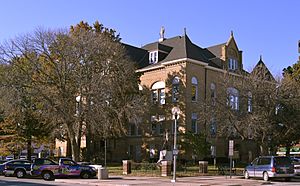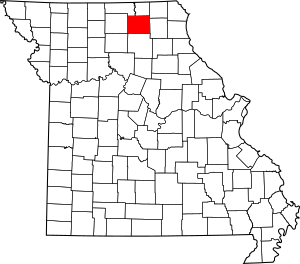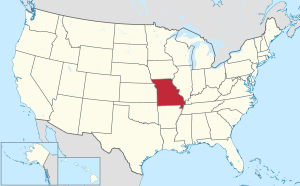Adair County, Missouri facts for kids
Quick facts for kids
Adair County
|
|
|---|---|

Adair County Courthouse in Kirksville
|
|

Location within the U.S. state of Missouri
|
|
 Missouri's location within the U.S. |
|
| Country | |
| State | |
| Founded | January 29, 1841 |
| Named for | Adair County, Kentucky |
| Seat | Kirksville |
| Largest city | Kirksville |
| Area | |
| • Total | 569 sq mi (1,470 km2) |
| • Land | 567 sq mi (1,470 km2) |
| • Water | 2.1 sq mi (5 km2) 0.4% |
| Population
(2020)
|
|
| • Total | 25,314 |
| • Density | 44.49/sq mi (17.177/km2) |
| Time zone | UTC−6 (Central) |
| • Summer (DST) | UTC−5 (CDT) |
| Congressional district | 6th |
Adair County is a county located in the northeastern part of the U.S. state of Missouri. As of the 2020 Census, the population was 25,314. Its county seat is Kirksville. The county was first settled by immigrants from Kentucky and organized on January 29, 1841.
Adair County comprises the Kirksville, MO Micropolitan Statistical Area.
Contents
History
The first permanent settlement in Adair County began in 1828. Many of the first settlers were from Kentucky, and Adair County was named for John Adair, a respected Governor of Kentucky. This was 25 years after the Louisiana Purchase, seven years after Missouri was granted statehood, and four years after the Sac and Fox Native American tribes surrendered their claims to the land. The original settlement was called "Cabins of White Folks," or simply, "The Cabins," and was located six miles (10 km) west of present-day Kirksville along the Chariton River.
The Big Neck War: In July 1829, a large party of Iowa (or Ioway) Native Americans, led by Chief Big Neck, returned to their former hunting grounds in violation of treaty. One of the Ioway's dogs killed a pig and they threatened (or insulted, according to some sources) the white women. The settlers sent messengers south to Randolph and Macon counties asking for help. Captain William Trammell responded with a party of some two dozen men to help. By the time of their arrival, the Ioways had left the area and moved upriver into what is now Schuyler County. Trammell's force, augmented by several of the men from The Cabins, pursed and engaged the Ioway at a place called Battle Creek, killing several Native Americans including Big Neck's brother, sister-in-law, and their child. The Trammell party lost three men in the skirmish, including Captain Trammell himself, and one additional casualty died of his wounds shortly afterward. The surviving whites returned to the cabins, collected the women and children, and headed south for the Randolph County settlement of Huntsville. Later, a group of militia under General John B. Clark pursued and apprehended Big Neck and his braves, capturing them in March 1830. Soon, several escaped from jail and fled to the current state of Iowa; however, Big Neck himself and the remainder were put on trial by a grand jury of Randolph County. The jury found on March 31, 1830, that: "After examining all the witnesses, and maturely considering the charges for which these Iowa Indians are now in confinement, we find them not guilty, and they are at once discharged." The acquittal of Big Neck seemed to have brought the war to a peaceful, if uneasy, conclusion. A few months later, white settlers returned to The Cabins, this time in greater numbers, and this time to stay permanently. The outbreak of the Blackhawk War in 1832 again caused consternation among the early settlers although all fighting was hundreds of miles away in present-day Illinois and Wisconsin. To ease fears in the area, militia units were dispatched and two small forts were constructed. One, Fort Clark, was located on high ground adjacent to The Cabins. Several miles to the northeast, another detachment of troops established Fort Matson. After months of no hostile Native American activity in the Adair County area, both forts were abandoned. The site of Fort Clark is now marked by a large boulder and plaque, while the Fort Matson site was later the location for a church, name corrupted to Fort Madison (not to be confused with the Iowa city). The Fort Matson/Madison Cemetery still remains.
Courthouse
The Adair County courthouse is a three story Romanesque structure in the center of the Kirksville city square that was completed in 1899. The architect was Robert G. Kirsch who would later also design the courthouses for Carroll, Polk, Vernon, and Cooper counties. The county had no dedicated courthouse from 1865 until 1899, operating out of temporary rented quarters on or near the square. The county voters finally approved a $50,000 bond issue in 1897 to build the current courthouse after four failed attempts between 1872 and 1896. The courthouse was placed on the National Register of Historic Places in 1978.
Geography
According to the U.S. Census Bureau, the county has a total area of 569 square miles (1,470 km2), of which 567 square miles (1,470 km2) is land and 2.1 square miles (5.4 km2) (0.4%) is water.
Adjacent counties
- Putnam County (northwest)
- Schuyler County (north)
- Scotland County (northeast)
- Knox County (east)
- Macon County (south)
- Linn County (southwest)
- Sullivan County (west)
Major highways
Demographics
| Historical population | |||
|---|---|---|---|
| Census | Pop. | %± | |
| 1850 | 2,283 | — | |
| 1860 | 8,436 | 269.5% | |
| 1870 | 11,448 | 35.7% | |
| 1880 | 15,190 | 32.7% | |
| 1890 | 17,417 | 14.7% | |
| 1900 | 21,728 | 24.8% | |
| 1910 | 22,700 | 4.5% | |
| 1920 | 21,404 | −5.7% | |
| 1930 | 19,436 | −9.2% | |
| 1940 | 20,246 | 4.2% | |
| 1950 | 19,689 | −2.8% | |
| 1960 | 20,105 | 2.1% | |
| 1970 | 22,472 | 11.8% | |
| 1980 | 24,870 | 10.7% | |
| 1990 | 24,577 | −1.2% | |
| 2000 | 24,977 | 1.6% | |
| 2010 | 25,607 | 2.5% | |
| 2020 | 25,314 | −1.1% | |
| U.S. Decennial Census 1790-1960 1900-1990 1990-2000 2010-2015 |
|||
As of the census of 2000, there were 24,977 people, 9,669 households, and 5,346 families residing in the county. The population density was 44 people per square mile (17/km2). There were 10,826 housing units at an average density of 19 per square mile (7/km2). The racial makeup of the county was 95.82% White, 1.20% Black or African American, 0.26% Native American, 1.39% Asian, 0.05% Pacific Islander, 0.41% from other races, and 0.88% from two or more races. Approximately 1.26% of the population were Hispanic or Latino of any race.
There were 9,669 households, out of which 25.20% had children under the age of 18 living with them, 45.50% were married couples living together, 7.20% had a female householder with no husband present, and 44.70% were non-families. 31.50% of all households were made up of individuals, and 10.50% had someone living alone who was 65 years of age or older. The average household size was 2.29 and the average family size was 2.90.
In the county, the population was spread out, with 19.20% under the age of 18, 27.40% from 18 to 24, 22.80% from 25 to 44, 18.40% from 45 to 64, and 12.30% who were 65 years of age or older. The median age was 28 years. For every 100 females, there were 88.20 males. For every 100 females age 18 and over, there were 84.50 males.
The median income for a household in the county was $26,677, and the median income for a family was $38,085. Males had a median income of $26,323 versus $21,837 for females. The per capita income for the county was $15,484. About 11.90% of families and 23.30% of the population were below the poverty line, including 16.80% of those under age 18 and 12.00% of those age 65 or over.
Religion
According to the Association of Religion Data Archives County Membership Report (2010), Adair County is sometimes regarded as being on the northern edge of the Bible Belt, with evangelical Protestantism being the most predominant religion. The most predominant denominations among residents in Adair County who adhere to a religion are Southern Baptists (19.73%), United Methodists (14.27%), and Roman Catholics (12.72%).
Communities
Cities
- Brashear
- Greentop
- Kirksville (county seat)
- Novinger
Villages
Unincorporated communities
Townships
Adair County is divided into ten townships:
- Benton
- Clay
- Liberty
- Morrow
- Nineveh
- Pettis
- Polk
- Salt River
- Walnut
- Wilson
Education
Public schools
-
- Adair County R-I Elementary School (K-06)
- Adair County R-I High School (07-12)
- Adair County R-II Elementary School (K-06)
- Adair County R-II High School (07-12)
- Kirksville Primary School (PK-02)
- Ray Miller Elementary School (03-05)
- Kirksville Middle School (06-08)
- Kirksville High School (09-12)
− ** La Plata R-2 Elementary School (K-06) − ** La Plata R-2 High School (07-12) − ** The La Plata R-2 facilities are located in La Plata, Missouri, in northern Macon County, Missouri, however the district boundaries encompass part of southern Adair County as well.
Private schools
Post-secondary education
- A.T. Still University - Kirksville - (Kirksville College of Osteopathic Medicine) - Satellite Campus
- Moberly Area Community College - Kirksville - A satellite campus of the main community college in Moberly
Public libraries
See also
 In Spanish: Condado de Adair (Misuri) para niños
In Spanish: Condado de Adair (Misuri) para niños

